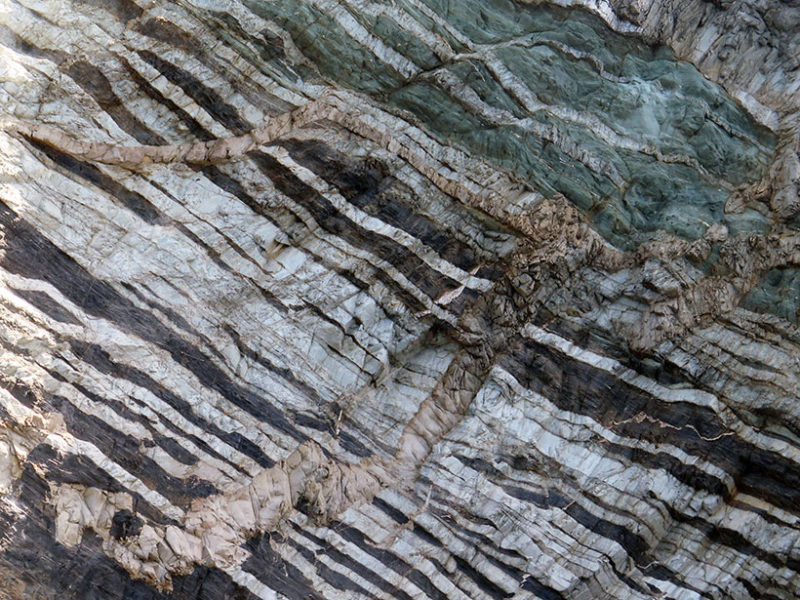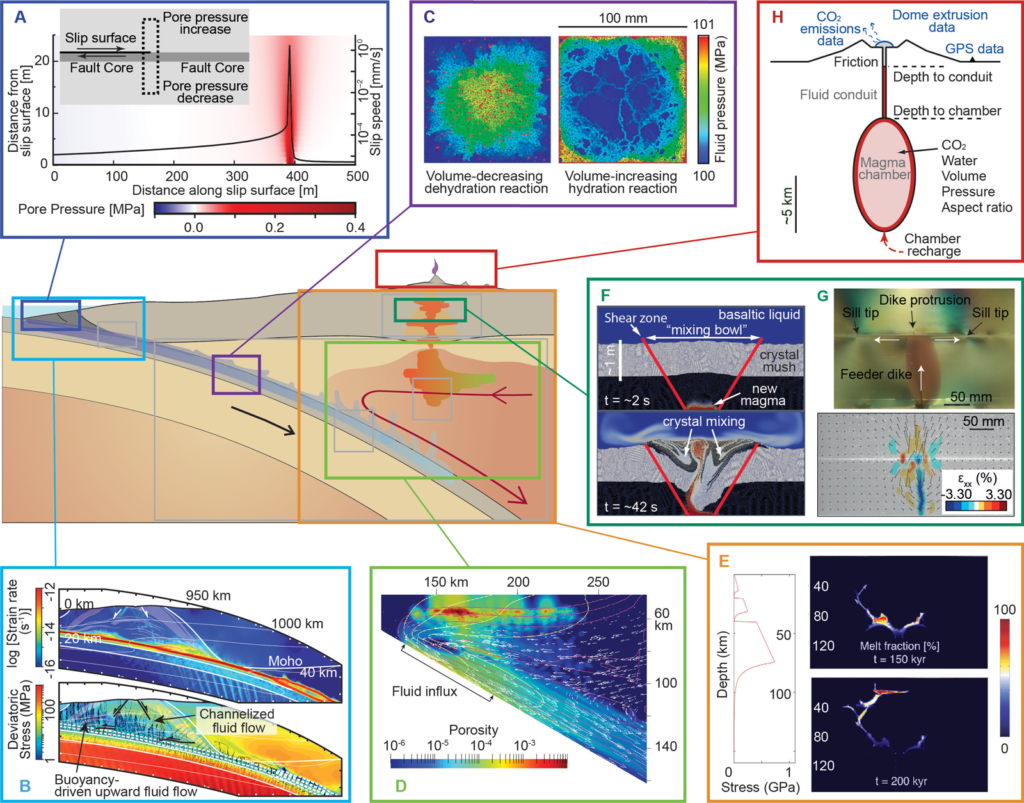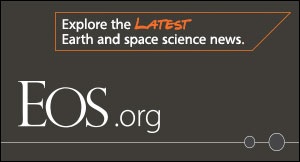16 June 2020
Ikuko Wada
iwada@umn.edu
Leif Karlstrom

The Franciscan complex on Santa Catalina Island in California exemplifies the role of fluids in subduction zone processes. In this outcrop, pale beige silicic magmatic dikes crosscut white quartz veins, likely reflecting distinct episodes of hydraulic fracturing of the crust by overpressurized fluids. Image width is about 12 meters. Credit: John Paul Platt
Some of the biggest challenges in understanding subduction zone processes and their associated hazards arise from the wide range of spatial and temporal scales of the underlying phenomena. Even if we look at the same question—say, how fluid migration affects megathrust faults or volcanic systems—various types of data and models available at different scales often lead to conclusions that are equally relevant but difficult to synthesize or validate.
To further research efforts on these issues, especially on subduction-related geohazards, a new community initiative called SZ4D has been developed. SZ4D expands upon international research in subduction zone science supported by the National Science Foundation (NSF) Geodynamic Processes at Rifting and Subducting Margins (GeoPRISMS) program, which is in its final stage. Allying with SZ4D, the NSF-funded Modeling Collaboratory for Subduction Research Coordination Network (MCS RCN) organized three workshops focused on identifying research approaches that could lead to more unified subduction science, particularly between volcanic and earthquake processes that historically have been studied independently. The hope is that these activities together will set off a wave of broad rethinking about the future directions of subduction zone science, with an integrated collaboratory to accelerate modeling efforts across disciplines.
Three Workshops
The first MCS RCN workshop was held at the University of Minnesota in May 2019 to address fluid migration as a basis for common future research directions across subduction science. With 56 in-person and 90 online participants, we obtained input from a range of Earth scientists, including modelers and observationalists at all career stages.
The second MCS RCN workshop, on modeling megathrust systems, was held at the University of Oregon in October 2019. And the third workshop, on modeling the subsurface aspects of volcanic systems, was scheduled for summer 2020, but its timing is now unknown.
The topic of the first workshop—migration of fluids (both aqueous and silicate melts)—is widely recognized as an integral component across subduction zone processes, including megathrust earthquakes like the 2011 Tohoku-Oki earthquake in Japan and volcanic eruptions like the 2019 eruption of Whakaari (White Island) in New Zealand, both of which caused the unanticipated loss of human lives and highlighted gaps in our understanding.
Current research on the dynamics of multiphase, multicomponent fluid systems is fragmented across many subdisciplines; thus, there are significant opportunities for synergy. Here we build on the outcome of the first workshop by highlighting opportunities and challenges in integrating models across spatial and temporal scales in subduction zones.
The Challenge of Scale
Most fluid migration studies focus on subdomains of subduction zones, such as the seismogenic part of the megathrust system, the ductile part of the mantle wedge, and the crustal magma transport system, as defined by the spatial or temporal scales of the processes being studied. This partitioning is artificial from a system-scale standpoint because these subdomains do not operate independently, but it is highly practical given that observations are often limited to restricted scales and the relation between subdomains is difficult to resolve.

Diagram illustrating key components of a subduction system and models of fluid transport processes for selected subdomains, highlighting different modeling approaches. (a) A dynamic earthquake rupture model showing pore pressure change across a fault (modified from Heimisson et al. [2019]). (b) A tens-of-kilometers-scale model of fluid flow and deformation in a megathrust system (modified from Menant et al. [2019]). (c) A micromechanical model of volume-decreasing dehydration (left) and volume-increasing hydration (right) reactions at mineral grain scale (modified from Okamoto and Shimizu [2015]). (d) A model for fluid circulation in the deforming mantle wedge with varying mineral grain size (magenta contours) and viscosity (yellow contours; modified from Cerpa et al. [2017]). (e) An integrated model for magma ascent from mantle through the lithosphere, showing a vertical strength profile (left), melt fraction (top right), and deviatoric strain rate (bottom right; modified from Keller et al. [2013]). (f) A model for a recharge event into a crystal-rich magma reservoir (modified from Bergantz et al. [2015]). (g) An analogue model for dike-to-sill emplacement in an elastic crust (modified from Kavanagh et al. [2018]). (h) Lumped parameter model for the 2004 Mount St. Helens volcanic eruption from a magma chamber through a volcanic conduit to a surface lava dome (modified from Anderson and Segall [2013]).
Mathematical models are often developed for a particular set of processes and subdomains with simplifying assumptions that are appropriate for the chosen scale but that may not be appropriate at other scales or in other subdomains. Such simplifications involve relegating unmodeled physical processes to initial and boundary conditions, parameterizing unmodeled processes, or simply ignoring them.
For example, larger-scale models of megathrust dynamics and arc magmatism must parameterize processes, such as multiphase reactive transport kinetics and fracture mechanics, that occur at smaller scales below the resolution of the numerical simulations. Smaller-scale models often face a similar problem in that they depend on larger-scale estimates of background stress, thermal states, or fluid flux that are not calculated within the smaller models and therefore must be specified on an ad hoc basis. Smaller-scale models might be viewed as elements that eventually fit into integrative models to provide larger-scale predictions, and indeed, one possible realization of the MCS RCN is to produce such a LEGO brick modeling framework.
Coupling Models and Achieving Consistency
Meaningfully coupling models is not trivial. Smaller-scale models focused on particular fluid processes in subduction zones are often subject to highly variable observational constraints or even to a lack of observational data. Larger integrative models face challenges involving the computational cost of incorporating processes on all relevant scales, requiring numerical approaches that push the limits of scientific computing.
One of the key challenges is how to properly couple processes that occur at different spatial and temporal scales. For example, how should the mechanics of slow slip modeled at the meter scale be incorporated in the deformation of the megathrust system that is modeled at a 100-kilometer scale and vice versa? How should elasticity and the brittle behavior of the crust around magma reservoirs and dikes be represented in lithospheric-scale magma migration models? Do unsteady and nonequilibrium effects arising from reactive transport in deformable two-phase media control fluid transport in the mantle wedge? Without the knowledge of how different phenomena influence each other, their overall effects are difficult to quantify.
Coupling models across different scales or subdomains in a consistent manner requires that we quantify fluid mass flux between domains, but this remains a significant challenge. For example, to predict magma flux into the lithosphere and subsequent volcanism at a narrow arc front or back-arc environment, we must know the permeability structure and melt ascent rates at the lithosphere-asthenosphere boundary. This in turn depends on the production and spatial focusing of melts within the mantle wedge below the boundary, which likely depend on fluid flux from the downgoing slab as well as on the evolving geometry of the lithosphere-asthenosphere boundary. Similarly, in quantifying the buildup of pore fluid pressure and the formation of hydrous phases in the megathrust system, we must know how much of the deep slab-derived fluid migrates within the downgoing material and along the plate interface.
Analogous issues arise in Earth surface landscape and critical zone evolution models that couple megathrust and volcanic activity to long-term climate. Such problems require an integrated system-scale approach that can resolve evolving plate geometry over millions of years with meters-per-year (or greater) ascent velocities of fluids. Models focused on particular processes (often at a smaller scale) play a crucial role in this development, but identifying the underlying physics and parameter sensitivity must be resolved using integrated models.
Commonalities in Fluid Migration Problems
Not all subduction zone subdomains exhibit the same degree of constraints or community consensus regarding validation—challenges that are illustrated by the variability of timing of earthquakes and volcanic eruptions. Both earthquakes and volcanic eruptions occur episodically in response to quasi-steady tectonic forcing (either plate loading or mantle melting) over long timescales. This forcing generates patterns of stress and fluid migration that affect the events’ occurrence and magnitude.
In volcanology, predictions of crustal magma storage and transport mechanisms that control the eruption cycle depend on poorly understood physical processes. Developing long-term eruption cycle models is thus difficult because of incomplete sampling of the full eruption magnitude-frequency distribution as well as of uncertainties in how to link to long-term constraints from the plutonic record with active volcanism. Earthquake cycle models are more mature in comparison.
When meaningful commonalities are found, opportunities arise for advancing both earthquake science and volcanology. For example, eruption cycle models might benefit from numerical approaches developed in modeling the multiscale deformation and fluid processes at play in the megathrust system. Likewise, earthquake cycle models could benefit from the multidisciplinary approach that volcanologists have developed to integrate multiscale constraints on fluid transport and storage. Identifying common ground for knowledge sharing and model development is a challenge that determines the practicality of system-scale models.
Observational Constraints
To better understand eruption and earthquake cycles or virtually any other grand challenge in subduction zone science, models must grapple with large variability in the degree of observational completeness. For example, one to three approximately magnitude 9 earthquakes occur every 100 years globally [McCaffrey, 2008], but among different faults, recurrence rates are more variable. Global recurrence intervals for the largest subduction-related volcanic eruptions (approximately magnitude 8 or greater based on erupted mass [Pyle, 2015]) are orders of magnitude larger [Rougier et al., 2018] and even more poorly constrained because of sparse records.
The distributions of smaller events that define earthquake and eruption cycles in terms of magnitude-frequency relationships are also distinct. Along instrumented megathrust faults, earthquakes as small as about magnitude zero can be recorded in some regions (e.g., Nankai, Japan [Nanjo and Yoshida, 2018]). Earthquake cycles also include a spectrum of slow-slip and aseismic-slip events that occur along the megathrust fault systems.
For arc volcanoes, a similar catalog of recent (Holocene) eruptions is considered complete down to a magnitude of perhaps 4 [Sheldrake and Carrichi, 2017], despite more frequent smaller events globally. This degree of completeness of the volcanic record reflects much poorer recording and preservation of eruptions relative to earthquakes. To complicate matters, pathways of magma ascent often migrate on timescales similar to eruption recurrence intervals. Thus, models for eruption cycles must account for both changing pathways and timescales of magma ascent, whereas megathrust earthquake cycles generally occur on known faults. Such differences in observational constraints represent an outstanding challenge for cross-disciplinary integration of earthquake and volcano science, requiring coordinated community efforts.
A Modeling Collaboratory
One vision of the MCS RCN is to identify and use integral components, such as the role of fluids, to unify subduction zone science. At the first workshop, participants agreed that there is a great need to address knowledge gaps among scientists working in different subduction zone subdomains. The MCS RCN’s long-term goal of building a framework of modeling and data analysis tools for subduction zone processes also requires resolving technical disconnects. We can envision a modeling collaboratory to provide a research environment in the form of workshops, training, and community forums to address both of those needs.
Building community modeling resources, such as approaches for model validation, uncertainty quantification, and benchmarking exercises, is important in disseminating research efforts effectively. The modeling collaboratory could serve as a platform for such activity, but maintaining cross-disciplinary research efforts will require that common objectives among different disciplines be clearly defined. The fluids workshop represented one organizational step toward this goal.
The full workshop report describes subduction zone–wide research foci from a fluids perspective and possible realizations for future collaborative efforts. A report from the second workshop is forthcoming.
[Please visit the full article for links to references cited.]
Acknowledgments
This article is built on the outcome of the first MCS RCN workshop, held at the University of Minnesota in May 2019, and we thank the workshop participants for their contribution. Special thanks are owed to the writing committee of the workshop report on which this article is partially based: D. Arcay, L. Caricchi, P. Fulton, T. Gerya, K. Iacovino, T. Keller, R. Lauer, G. Lotto, L. Montesi, T. Sun, H. Vrijmoed, and J. Warren. We also thank K. Anderson, G. Bergantz, N. Cerpa, E. Heimisson, J. Kavanagh, T. Keller, A. Menant, and A. Okamoto for providing the plots included in the figure. This article benefited from insightful comments from the MCS RCN Steering Committee and the Writing Committee. L.K. acknowledges support from NSF grant 1848554.
References
Anderson, K., and P. Segall (2013), Bayesian inversion of data from effusive volcanic eruptions using physics‐based models: Application to Mount St. Helens 2004–2008, J. Geophys. Res. Solid Earth, 118(5), 2,017–2,037, https://doi.org/10.1002/jgrb.50169.
Bergantz, G. W., J. M. Schleicher, and A. Burgisser (2015), Open-system dynamics and mixing in magma mushes, Nat. Geosci., 8(10), 793–796, https://doi.org/10.1038/ngeo2534.
Cerpa, N. G., I. Wada, and C. R. Wilson (2017), Fluid migration in the mantle wedge: Influence of mineral grain size and mantle compaction, J. Geophys. Res. Solid Earth, 122(8), 6,247–6,268, https://doi.org/10.1002/2017JB014046.
Heimisson, E. R., E. M. Dunham, and M. Almquist (2019), Poroelastic effects destabilize mildly rate-strengthening friction to generate stable slow slip pulses, J. Mech. Phys. Solids, 130, 262–279, https://doi.org/10.1016/j.jmps.2019.06.007.
Kavanagh, J. L., et al. (2018), Challenging dyke ascent models using novel laboratory experiments: Implications for reinterpreting evidence of magma ascent and volcanism, J. Volcanol. Geotherm. Res., 354, 87–101, https://doi.org/10.1016/j.jvolgeores.2018.01.002.
Keller, T., D. A. May, and B. J. P. Kaus (2013), Numerical modelling of magma dynamics coupled to tectonic deformation of lithosphere and crust, Geophys. J. Int., 195(3), 1,406–1,442, https://doi.org/10.1093/gji/ggt306.
McCaffrey, R. (2008), Global frequency of magnitude 9 earthquakes, Geology, 36(3), 263–266, https://doi.org/10.1130/G24402A.1.
Menant, A., S. Angiboust, and T. Gerya (2019), Stress-driven fluid flow controls long-term megathrust strength and deep accretionary dynamics, Sci. Rep., 9, 9714, https://doi.org/10.1038/s41598-019-46191-y.
Nanjo, K. Z., and A. Yoshida (2018), A b map implying the first eastern rupture of the Nankai Trough earthquakes, Nat. Commun., 9, 1117, https://doi.org/10.1038/s41467-018-03514-3.
Okamoto, A., and H. Shimizu (2015), Contrasting fracture patterns induced by volume-increasing and -decreasing reactions: Implications for the progress of metamorphic reactions, Earth Planet. Sci. Lett., 417, 9–18, https://doi.org/10.1016/j.epsl.2015.02.015.
Pyle, D. (2015), Sizes of volcanic eruptions, in The Encyclopedia of Volcanoes, 2nd ed., edited by H. Sigurdsson et al., chap. 13, pp. 257–264, Academic, Waltham, Mass., https://doi.org/10.1016/B978-0-12-385938-9.00013-4.
Rougier, J., et al. (2018), The global magnitude–frequency relationship for large explosive volcanic eruptions, Earth Planet. Sci. Lett., 482, 621–629, https://doi.org/10.1016/j.epsl.2017.11.015.
Sheldrake, T., and L. Caricchi (2017), Regional variability in the frequency and magnitude of large explosive volcanic eruptions, Geology, 45(2), 111–114, https://doi.org/10.1130/G38372.1.
See the full article here .
five-ways-keep-your-child-safe-school-shootings
Please help promote STEM in your local schools.
Eos is the leading source for trustworthy news and perspectives about the Earth and space sciences and their impact. Its namesake is Eos, the Greek goddess of the dawn, who represents the light shed on understanding our planet and its environment in space by the Earth and space sciences.

